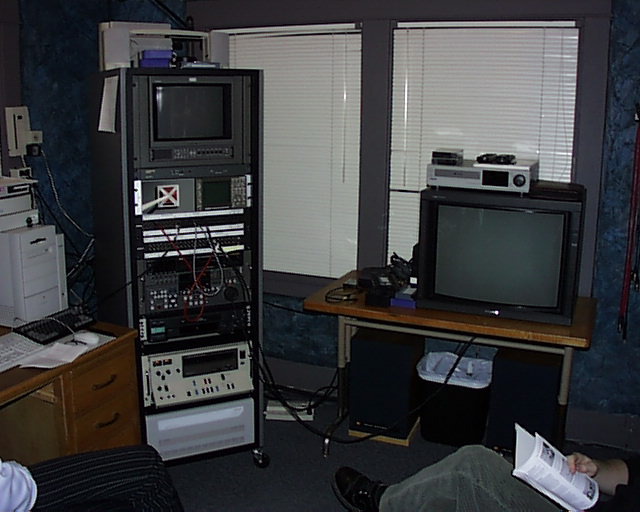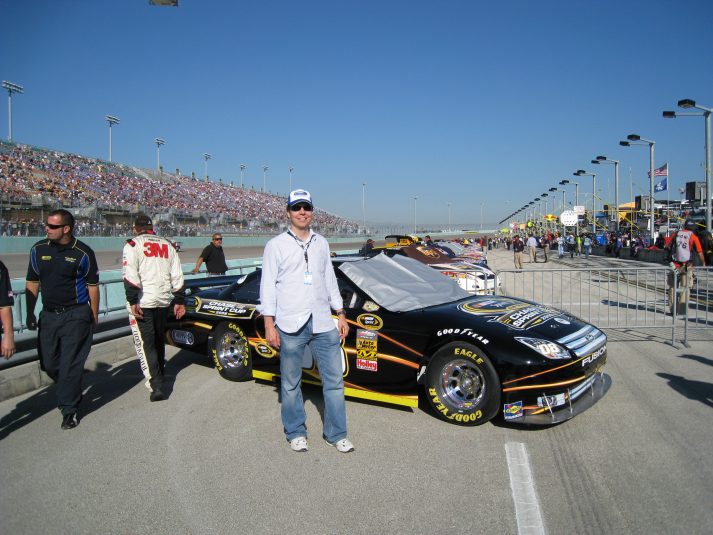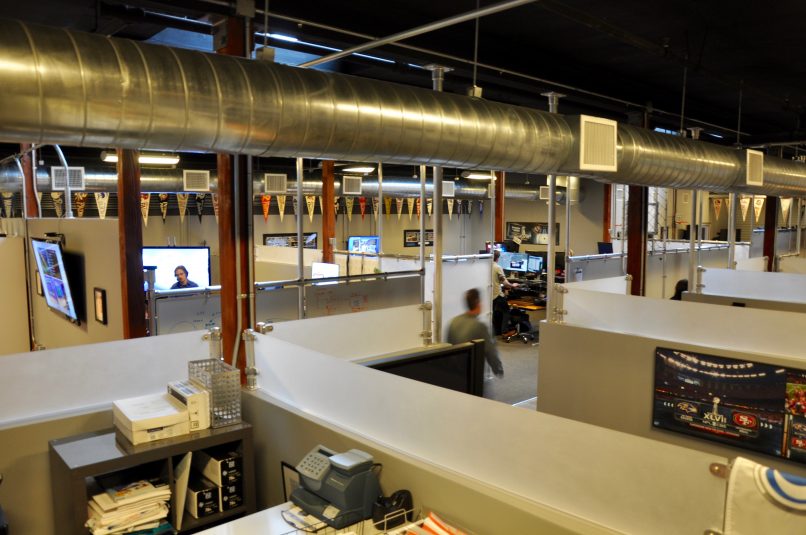SVG Sit-Down: Co-Founder Steven Heimbold Reflects on Reality Check Systems’ 20 Years
From a tiny Los Angeles apartment to facilities there and in the UK and a team of 45
Story Highlights
In February 1997, cousins Andrew and Steven Heimbold launched Reality Check Studios out of a modest office in Hollywood. At the time, the motion-graphics and effects studio housed a team of three and collaborated with one client. Known today as Reality Check Systems, RCS now has offices in Burbank, CA, and the UK and a team of 45 and has worked with prestigious federations, leagues, networks, and social-media giants from around the world.
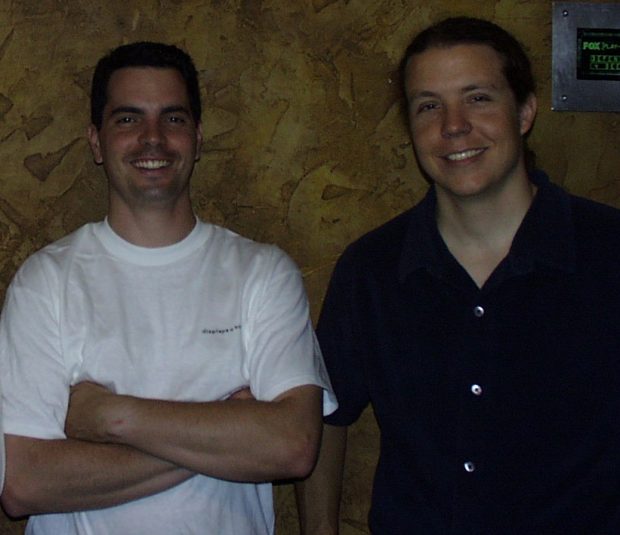
RCS founders Steven Heimbold (left) and Andrew Heimbold are all smiles in the Cahuenga Blvd. office circa 1999.
With RCS turning 20, SVG sat down with RCS co-founder/Executive Producer Steven Heimbold to discuss two decades in the business, how the market has evolved, and where he sees technology heading in the future.
How was Reality Check Systems (RCS) formed? Why the name Reality Check?
It began in 1997 when I convinced my cousin Andrew Heimbold to move to L.A., where I was working in film advertising. He was in San Diego running a website-design company and came to L.A. to work with me on animated movie titles for film trailers, as the Mac was just becoming viable for serious 3D. Some of our early projects were Buddy and Dante’s Peak.
After a year, we decided to start up an effects company with our friend Kory Jones. We kept taking on trailer-title work and eventually expanded to effects shots for films; TV and advertising work followed.
Clients came to us specifically because of our experience creating photoreal 3D work. In 1997, Fox approached us with an NFL project, which marked our foray into sports graphics. It earned a Sports Emmy for Outstanding Graphic Design and put RCS on the map.
As for the name Reality Check, we chose it to reflect our desire to make realistic-looking film effects.
What clients have you worked with?
ABC, AT&T DirecTV, beIN Sports, Bundesliga, CBS Sports, ESPN, F1, Facebook, Fox, Freemantle, Golf Channel, Microsoft, MLB Network, NASCAR, NBC, NFL, NHL, Perform Group, RIOT Games, SBS Discovery, Sky Sports, Spike, Turner, Twitter, UFC, Univision, U.S. Armed Forces, WTA Media, and many more.
How has RCS grown over the years?
We started as a three-person team working out of my L.A. apartment, with every horizontal surface covered in gear. After six months, we rented a tiny house on Cahuenga Blvd. in Hollywood that had been converted to an office. It had a lot of tiny rooms and crooked floors and walls, so crooked that your chair would literally roll away when you stood up. But it had charm and was great for two years.
When we finally outgrew the space, we bought a warehouse around the corner on Melrose Ave. and converted it into our next office.
From ’98 to ’00, I also ran a small New York office that we opened to be close to CBS Sports for an NFL project we were working on with a company that later became Vizrt. It was one of their first-ever North American projects, and our collaboration with Viz is still strong.
In 2010, we settled into our current Burbank headquarters, which became home. We also have an EMEA satellite office, currently in Amersham, UK, that we launched in 2014 as our relationships with international broadcasters and leagues expanded. Today, our team includes 45 employees worldwide.
The Fox NFL project jumpstarted our business, and, when CBS came to us in 1998 for an NFL AFC project, Reality Check really took off. In 2004, we landed a retainer deal with ESPN; deals with NFL Network, MLB, and DirecTV soon followed. Shortly thereafter, our first international client, Sky Italy, signed on, and we’ve just continued to grow.
Technologically speaking, we extended our services to include the development of backend solutions to drive our graphics in 2004, building and assembling our first remote graphics system in a cubicle at ESPN. Three years later, Uppercut — our video-switching, data-parsing and graphics triggering system — was born out of a NASCAR project with DirecTV. In 2014 came LaunchPad, an interactive application we built for soccer graphics and analysis, powered by Foundation, our cloud solution designed to parse and process data for real-time graphics delivery.
RCS’s latest innovation, announced before IBC 2016, involves Singular, a cloud-based platform for creating and delivering personalized, interactive graphics across smartphones, tablets, TVs, etc. We’ll be talking more about it in 2017 as we begin to leverage the platform for clients.
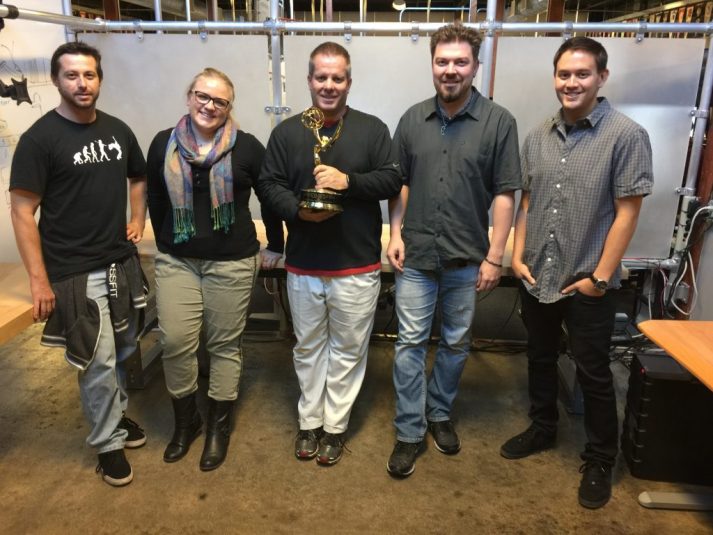
RCS’s CBS Sports Super Bowl 50 Dream Team celebrate another Sports-Emmy award for graphics: (from left) Travis Doyel, Terry Kelly, Glenn White, Greg Rodwell, Ryan Wong
What is the biggest challenge you’ve faced?
The toughest challenge we’ve encountered is finding the right talent. What we do is very specialized, so the pool can be limited. Regardless, we’ve been able to build a team and grow by investing in the people we bring on.
What technological advances and trends have changed how your team works?
Hardware requirements are a fraction of what they used to be; rack rooms just keep shrinking as the industry migrates to the cloud, which makes for a more nimble environment than 20 years ago. We’ve gone from working on massive $150,000 Onyx systems, to desktop PCs that have grown faster and more capable, and now real-time graphics rendering in an HTML interface — all of which have expanded what we’ve been able to do for our clients. With all these technological developments come a lot more client requests that require custom-software builds, so we have more programmers and engineers on our team today than creatives; 10 years ago, it was the reverse.
Automation has also changed the game. In the early days, you had graphics and the frontend, but the automation of broadcast graphics has made it easy to integrate data from multiple sources with graphics in real time. It’s the glue that holds raw data and on-air visualization together and will soon make the localization of graphics and rendering possible.
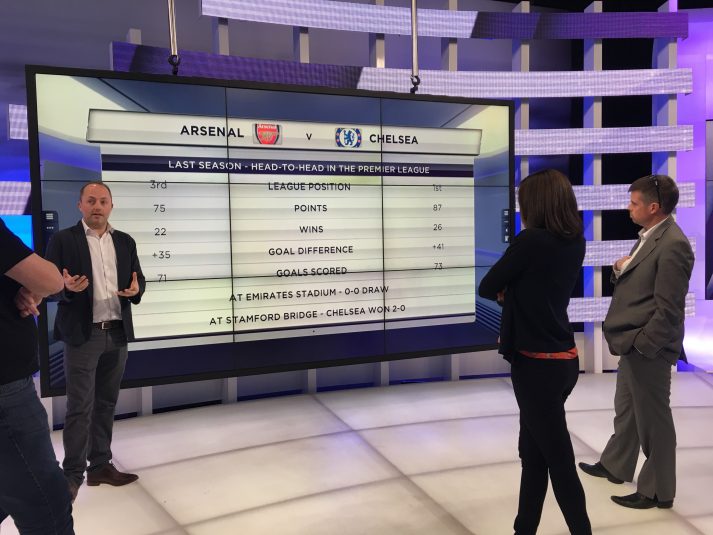
Mike Ward, managing director, EMEA, RCS, on-set at beIN Sports in Doha training talent on RCS LaunchPad in 2015
The touchscreen has also been huge. Our Uppercut and LaunchPad touch interfaces make graphics integration into live broadcasts simpler.
Trends-wise, we’ve lived through a lot of transitions. When we first started, it was all about Beta tapes, and now everything is digital. Then, there was the move from SD to HD, which improved the quality of graphics immensely, and now we’re working in 4K and customizing our Bullets [mobile graphics workstations] for UHD broadcasts.
Our latest investment in Singular will only push the needle forward. Through all these changes however, one thing remains constant: real time. We’ve built a business on delivering real-time graphics for live productions, and that knowledge translates as we evolve with technology and trends.
How do you envision the future of sports?
We’re going to see more personalized content and advertising. As we inch toward client-side rendering, consumers will be able to multitask on digital devices while watching a sporting event. For example, while watching a game in an app, a consumer could be texting from the same app. Live content is poised to become much more targeted to the individual.
